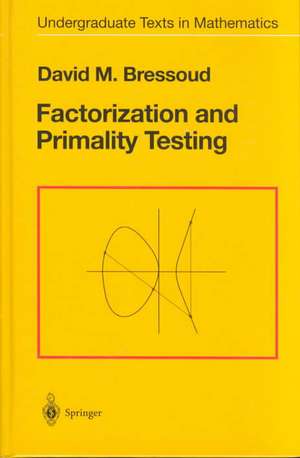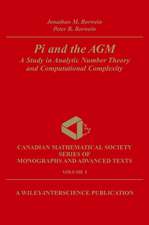Factorization and Primality Testing: Undergraduate Texts in Mathematics
Autor David M. Bressouden Limba Engleză Hardback – 2 oct 1989
| Toate formatele și edițiile | Preț | Express |
|---|---|---|
| Paperback (1) | 485.18 lei 6-8 săpt. | |
| Springer – 26 sep 2011 | 485.18 lei 6-8 săpt. | |
| Hardback (1) | 490.75 lei 6-8 săpt. | |
| Springer – 2 oct 1989 | 490.75 lei 6-8 săpt. |
Din seria Undergraduate Texts in Mathematics
- 17%
 Preț: 362.13 lei
Preț: 362.13 lei - 17%
 Preț: 365.42 lei
Preț: 365.42 lei - 20%
 Preț: 466.83 lei
Preț: 466.83 lei -
 Preț: 370.77 lei
Preț: 370.77 lei -
 Preț: 351.54 lei
Preț: 351.54 lei - 17%
 Preț: 368.60 lei
Preț: 368.60 lei -
 Preț: 304.91 lei
Preț: 304.91 lei -
 Preț: 257.71 lei
Preț: 257.71 lei -
 Preț: 380.26 lei
Preț: 380.26 lei -
 Preț: 400.42 lei
Preț: 400.42 lei -
 Preț: 280.65 lei
Preț: 280.65 lei -
 Preț: 372.26 lei
Preț: 372.26 lei - 17%
 Preț: 373.59 lei
Preț: 373.59 lei - 17%
 Preț: 367.24 lei
Preț: 367.24 lei -
 Preț: 358.10 lei
Preț: 358.10 lei -
 Preț: 339.36 lei
Preț: 339.36 lei - 17%
 Preț: 366.38 lei
Preț: 366.38 lei -
 Preț: 290.80 lei
Preț: 290.80 lei - 17%
 Preț: 362.67 lei
Preț: 362.67 lei - 17%
 Preț: 395.93 lei
Preț: 395.93 lei -
 Preț: 407.96 lei
Preț: 407.96 lei -
 Preț: 298.00 lei
Preț: 298.00 lei -
 Preț: 359.48 lei
Preț: 359.48 lei -
 Preț: 415.94 lei
Preț: 415.94 lei -
 Preț: 407.62 lei
Preț: 407.62 lei -
 Preț: 364.40 lei
Preț: 364.40 lei -
 Preț: 332.02 lei
Preț: 332.02 lei -
 Preț: 402.33 lei
Preț: 402.33 lei -
 Preț: 400.42 lei
Preț: 400.42 lei -
 Preț: 440.01 lei
Preț: 440.01 lei - 15%
 Preț: 417.73 lei
Preț: 417.73 lei - 13%
 Preț: 389.61 lei
Preț: 389.61 lei -
 Preț: 424.14 lei
Preț: 424.14 lei -
 Preț: 433.85 lei
Preț: 433.85 lei -
 Preț: 395.09 lei
Preț: 395.09 lei - 19%
 Preț: 400.52 lei
Preț: 400.52 lei -
 Preț: 329.94 lei
Preț: 329.94 lei - 19%
 Preț: 492.82 lei
Preț: 492.82 lei -
 Preț: 396.24 lei
Preț: 396.24 lei -
 Preț: 390.08 lei
Preț: 390.08 lei - 15%
 Preț: 521.04 lei
Preț: 521.04 lei -
 Preț: 402.00 lei
Preț: 402.00 lei - 15%
 Preț: 531.72 lei
Preț: 531.72 lei - 15%
 Preț: 447.81 lei
Preț: 447.81 lei - 15%
 Preț: 533.53 lei
Preț: 533.53 lei -
 Preț: 390.08 lei
Preț: 390.08 lei
Preț: 490.75 lei
Nou
Puncte Express: 736
Preț estimativ în valută:
93.91€ • 98.50$ • 78.17£
93.91€ • 98.50$ • 78.17£
Carte tipărită la comandă
Livrare economică 01-15 aprilie
Preluare comenzi: 021 569.72.76
Specificații
ISBN-13: 9780387970400
ISBN-10: 0387970401
Pagini: 240
Ilustrații: XIV, 240 p.
Dimensiuni: 156 x 234 x 20 mm
Greutate: 0.49 kg
Ediția:1989
Editura: Springer
Colecția Springer
Seria Undergraduate Texts in Mathematics
Locul publicării:New York, NY, United States
ISBN-10: 0387970401
Pagini: 240
Ilustrații: XIV, 240 p.
Dimensiuni: 156 x 234 x 20 mm
Greutate: 0.49 kg
Ediția:1989
Editura: Springer
Colecția Springer
Seria Undergraduate Texts in Mathematics
Locul publicării:New York, NY, United States
Public țintă
GraduateCuprins
1 Unique Factorization and the Euclidean Algorithm.- 1.1 A theorem of Euclid and some of its consequences.- 1.2 The Fundamental Theorem of Arithmetic.- 1.3 The Euclidean Algorithm.- 1.4 The Euclidean Algorithm in practice.- 1.5 Continued fractions, a first glance.- 1.6 Exercises.- 2 Primes and Perfect Numbers.- 2.1 The Number of Primes.- 2.2 The Sieve of Eratosthenes.- 2.3 Trial Division.- 2.4 Perfect Numbers.- 2.5 Mersenne Primes.- 2.6 Exercises.- 3 Fermat, Euler, and Pseudoprimes.- 3.1 Fermat’s Observation.- 3.2 Pseudoprimes.- 3.3 Fast Exponentiation.- 3.4 A Theorem of Euler.- 3.5 Proof of Fermat’s Observation.- 3.6 Implications for Perfect Numbers.- 3.7 Exercises.- 4 The RSA Public Key Crypto-System.- 4.1 The Basic Idea.- 4.2 An Example.- 4.3 The Chinese Remainder Theorem.- 4.4 What if the Moduli are not Relatively Prime?.- 4.5 Properties of Euler’s ø Function.- Exercises.- 5 Factorization Techniques from Fermat to Today.- 5.1 Fermat’s Algorithm.- 5.2 Kraitchik’s Improvement.- 5.3 Pollard Rho.- 5.4 Pollard p — 1.- 5.5 Some Musings.- 5.6 Exercises.- 6 Strong Pseudoprimes and Quadratic Residues.- 6.1 The Strong Pseudoprime Test.- 6.2 Refining Fermat’s Observation.- 6.3 No “Strong” Carmichael Numbers.- 6.4 Exercises.- 7 Quadratic Reciprocity.- 7.1 The Legendre Symbol.- 7.2 The Legendre symbol for small bases.- 7.3 Quadratic Reciprocity.- 7.4 The Jacobi Symbol.- 7.5 Computing the Legendre Symbol.- 7.6 Exercises.- 8 The Quadratic Sieve.- 8.1 Dixon’s Algorithm.- 8.2 Pomerance’s Improvement.- 8.3 Solving Quadratic Congruences.- 8.4 Sieving.- 8.5 Gaussian Elimination.- 8.6 Large Primes and Multiple Polynomials.- 8.7 Exercises.- 9 Primitive Roots and a Test for Primality.- 9.1 Orders and Primitive Roots.- 9.2 Properties of Primitive Roots.- 9.3Primitive Roots for Prime Moduli.- 9.4 A Test for Primality.- 9.5 More on Primality Testing.- 9.6 The Rest of Gauss’ Theorem.- 9.7 Exercises.- 10 Continued Fractions.- 10.1 Approximating the Square Root of 2.- 10.2 The Bháscara-Brouncker Algorithm.- 10.3 The Bháscara-Brouncker Algorithm Explained.- 10.4 Solutions Really Exist.- 10.5 Exercises.- 11 Continued Fractions Continued, Applications.- 11.1 CFRAC.- 11.2 Some Observations on the Bháscara-Brouncker Algorithm.- 11.3 Proofs of the Observations.- 11.4 Primality Testing with Continued Fractions.- 11.5 The Lucas-Lehmer Algorithm Explained.- 11.6 Exercises.- 12 Lucas Sequences.- 12.1 Basic Definitions.- 12.2 Divisibility Properties.- 12.3 Lucas’ Primality Test.- 12.4 Computing the V’s.- 12.5 Exercises.- 13 Groups and Elliptic Curves.- 13.1 Groups.- 13.2 A General Approach to Primality Tests.- 13.3 A General Approach to Factorization.- 13.4 Elliptic Curves.- 13.5 Elliptic Curves Modulo p.- 13.6 Exercises.- 14 Applications of Elliptic Curves.- 14.1 Computation on Elliptic Curves.- 14.2 Factorization with Elliptic Curves.- 14.3 Primality Testing.- 14.4 Quadratic Forms.- 14.5 The Power Residue Symbol.- 14.6 Exercises.- The Primes Below 5000.











